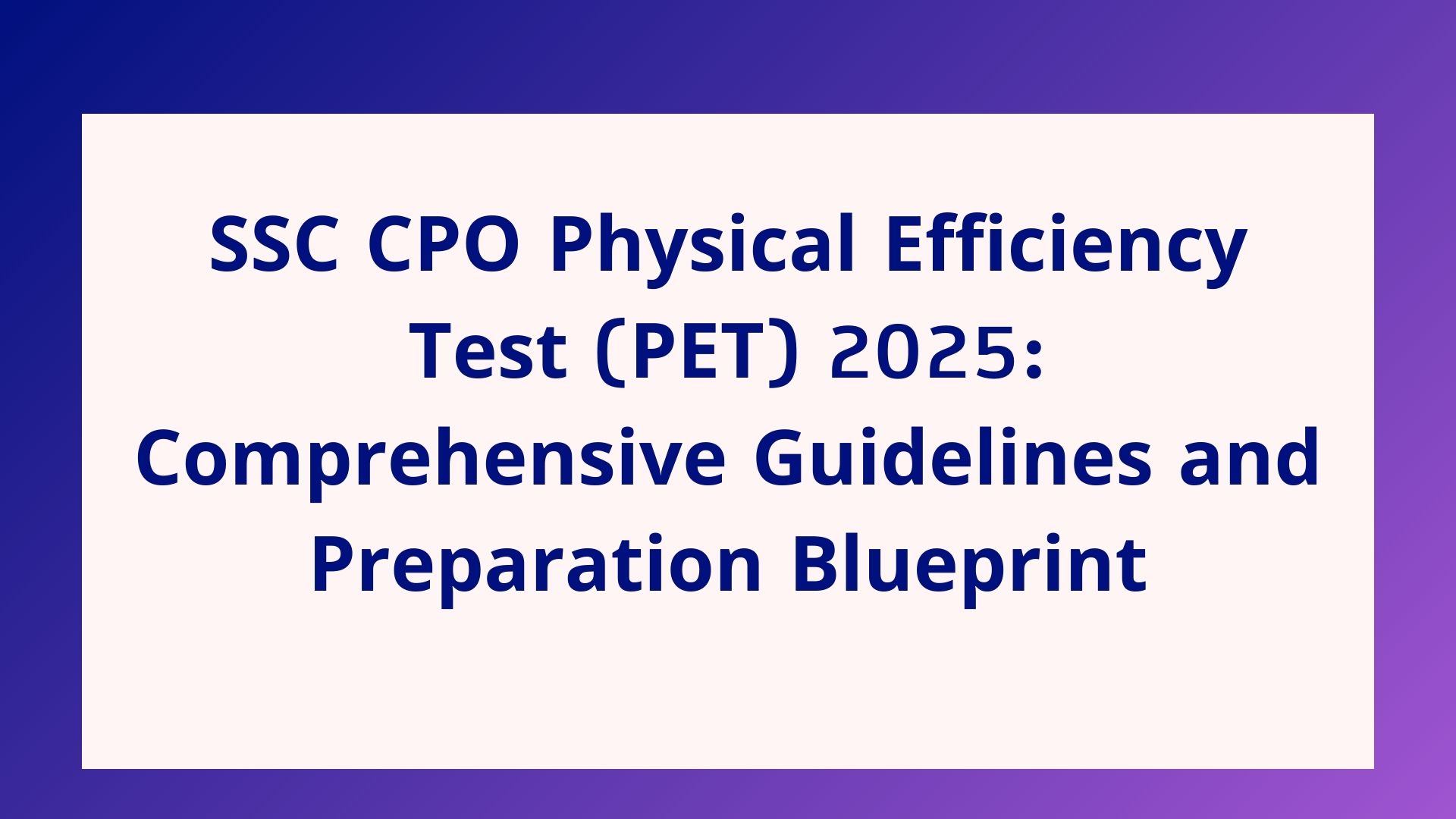For candidates aspiring to serve in the Central Police Organizations (CPO), the Physical Efficiency Test (PET) is a decisive stage in the SSC CPO recruitment process. While many prepare intensely for the written examination, the PET is often underestimated—despite being a key determinant in the selection journey. Success here requires more than just raw physical strength; it demands stamina, agility, discipline, and mental resilience.
In this detailed guide, we’ll walk you through every crucial aspect of the SSC CPO PET 2025, including official test requirements, expert tips, strategic preparation plans, and success stories of previous candidates. If you’re serious about clearing this stage, this article will be your go-to resource.
Key Highlights 
| Criteria | Details |
|---|---|
| Recruiting Authority | Staff Selection Commission (SSC) |
| Exam Name | SSC CPO Physical Efficiency Test (PET) |
| Eligibility | Must clear Paper-I of SSC CPO Examination |
| PET Includes | Running, Long Jump, High Jump |
| Applicable Posts | Sub-Inspector in Delhi Police, CAPFs |
| Duration of PET | Completed in one day |
| Mode | Offline, Physical Participation Required |
| Website | ssc.nic.in |
Understanding the SSC CPO PET 
The SSC CPO PET is designed to evaluate a candidate’s physical readiness for duties in high-demand environments. It includes events that test speed, endurance, and coordination.
Eligibility Note: Only candidates who qualify in Paper-I of the SSC CPO examination are called for the PET/Physical Standard Test (PST).
Detailed Breakdown of PET Components
 For Male Candidates:
For Male Candidates:
- 100-meter race: Must be completed in 16 seconds
- 1.6-km race: Must be completed in 6 minutes and 30 seconds
- Long Jump: Minimum 3.65 meters in 3 attempts
- High Jump: Minimum 1.2 meters in 3 attempts
- Shot Put (16 lbs): 4.5 meters in 3 attempts
 For Female Candidates:
For Female Candidates:
- 100-meter race: Must be completed in 18 seconds
- 800-meter race: Must be completed in 4 minutes
- Long Jump: Minimum 2.7 meters in 3 attempts
- High Jump: Minimum 0.9 meters in 3 attempts
Why PET is a Make-or-Break Stage
According to the Ministry of Home Affairs, nearly 1 in 3 candidates fail the PET. The reasons range from lack of preparation to overconfidence. Importantly, PET is qualifying in nature, but a failure means automatic disqualification, regardless of your written scores.
Example:
Rahul Sharma, a high-scoring candidate in 2024, missed clearing the 1.6-km run by just 8 seconds. “I thought I could wing it because I used to be fit during college. That overconfidence cost me my selection,” he admitted.
Expert Tips to Ace the PET
We consulted two experts for practical advice:
 Dr. Anjali Mehta (Fitness Coach for Competitive Exams)
Dr. Anjali Mehta (Fitness Coach for Competitive Exams)
- Start Early: Begin training at least 4–6 months in advance.
- Consistency Beats Intensity: “Even 45 minutes a day can make a difference if done regularly.”
- Cardio is Key: Focus on building stamina with interval running, cycling, and skipping.
- Stretch to Prevent Injury: Warm-ups and cool-downs are non-negotiable.
 Ravi Kumar (Retired DSP, CAPF Trainer)
Ravi Kumar (Retired DSP, CAPF Trainer)
- Simulate Test Conditions: Practice in full gear, on a track, under similar time limits.
- Stay Calm: “I’ve seen great athletes fail due to nervousness. Train your mind as much as your body.”
Structured Preparation Plan (20 Weeks) 
Here’s a sample 5-month strategy:
| Week Range | Focus Area | Activities |
|---|---|---|
| 1–4 | Base Building | Light jogging, dynamic stretches, yoga |
| 5–8 | Stamina & Endurance | Interval runs, swimming, brisk walking |
| 9–12 | Skill Training | Practice long jump, high jump, race timing |
| 13–16 | Strength Development | Squats, lunges, push-ups, hill sprints |
| 17–18 | Mock PET Simulations | Full PET rehearsals under time restrictions |
| 19–20 | Taper & Recovery | Active rest, light cardio, meditation |
Common Mistakes to Avoid
| Mistake | Impact | Solution |
|---|---|---|
| Ignoring cardio workouts | Poor performance in running events | Incorporate daily running/jogging |
| Skipping warm-ups | Increased risk of injuries | Always do a 10-minute warm-up session |
| Poor time planning | Incomplete preparation | Use a weekly planner with milestone goals |
| Overtraining close to PET | Leads to fatigue, injuries | Reduce intensity in last 2 weeks |
| Ignoring hydration/diet | Affects stamina and muscle recovery | Maintain a balanced, protein-rich diet |
Real-Life Success Stories
 Priya’s Journey: From Average to Outstanding
Priya’s Journey: From Average to Outstanding
Priya, a 25-year-old from Lucknow, struggled with the high jump during her initial attempts. But with six months of structured training—including strength and flexibility drills—she cleared the PET with ease. “Daily 5 AM jogs and journaling my workouts kept me disciplined,” she recalls.
 Arjun’s Smart Strategy
Arjun’s Smart Strategy
Arjun, an ex-national level athlete, had the physical edge—but even he didn’t take success for granted. “I treated it like a tournament,” he says. “I scheduled rest days, focused on hydration, and kept a calm mindset.”
Research & Statistics: What the Data Says
According to a 2024 study by the National Institute of Physical Education, candidates with a structured 12+ week plan had:
- 40% higher clearance rates
- 60% fewer injuries during PET
- Better recovery and confidence levels
Additionally, the study found that mental preparedness (meditation, breathing exercises) enhanced physical performance by up to 15%.
Final Thoughts
Cracking the SSC CPO PET 2025 requires more than last-minute sprints. It calls for discipline, focus, and consistency over months. Treat your body as your most important tool in this journey. Start today—train smart, eat well, and stay mentally resilient.
And remember, every officer in uniform once stood where you are now—unsure, anxious, but determined. With the right strategy and mindset, you can cross the finish line with pride.
